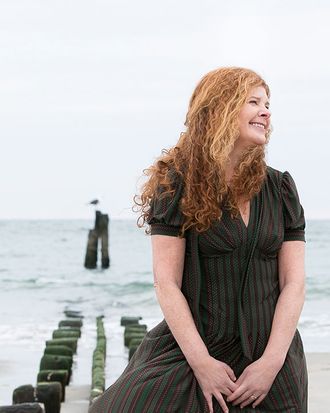
“The water was up to the second floor,” Jill Eisenstadt is saying. She’s standing in front of her father’s house just off the beach in Rockaway, and talking about the night of Hurricane Sandy. “This is the house in the book, although I moved it.” In real life, the hurricane damage has been put right, and is somewhere where you’d be happy to spend a summer weekend. In Eisenstadt’s new novel Swell, the house is a beat-up old thing, “and I set it on 126th, because that’s where the Boardwalk starts. I was trying to think of Rockaway, how it’s kind of a character in the book — it’s got a lot of scars, and it’s haunted.”
Rockaway is indeed kind of a character in Eisenstadt’s novel, and in her entire career as an author. In 1987, she was just out of a pair of writing programs (Bennington, Columbia) when Knopf published her first novel, about a bunch of the neighborhood’s teenagers. From Rockaway was, for lack of a better term, a buzzy book. (It had a great, memorable opening scene in a prom-night limo.) And there were several other buzzy books just then by 20-something novelists, a couple of whom — most prominently Bret Easton Ellis — had gone to Bennington at the same time as she. They all got swept up into a cobbled-together media construct constantly referred to as “the Literary Brat Pack.” Never mind that their books had very little in common, apart from being About Youth; the authors were easy to clump, and easy to mock, particularly Ellis. The buzz pretty quickly turned into a buzz saw. Jay McInerney survived and flourished. Ellis got carved up a few years later for American Psycho, but hung on and remained a media figure. Eisenstadt, though, took the knocks hard. She published a second novel, Kiss Out, that (like a lot of buzzy writers’ second novels) was decently received but didn’t sell like her first. She wrote a third that she didn’t sell to anyone — that is, it went in a drawer. And then …
“Well, I told myself I wasn’t going to be a novelist of the outer boroughs,” she says today. She was worried about being pigeonholed, about working the same turf too many times. Then her kids were born — she has three — and although she kept writing for magazines and working on screenplays and such, all of it was less visible than her fiction had been. (She also had a frightening experience when the street outside her apartment blew up, dousing her possessions in mud laced with asbestos.) She did not disappear, but she receded from the aforementioned buzz, and fell out of public view.
A couple of years ago, when Eisenstadt’s youngest daughter was in high school, the two of them got into a text-message exchange that turned out to be more profound than anyone expected. “Why do you insist on banging your head against the wall, doing these things that give you trouble,” the author asked her daughter. “When there are all these things you’re really great at?” Why indeed — and why fight that outer-borough-novelist label? And not all that much later, Terry Adams, the same editor who acquired her first book for Knopf, bought this one for Lee Boudreaux Books at Little, Brown.
There was, briefly, talk of calling it Back to Rockaway, but Eisenstadt agreed that it seemed a little like Son of Frankenstein. So Swell it is, a word about ocean waves but also tumescence, retro fun but also growth. The dust jacket image resembles a beach community’s tempera-painted sign. Little, Brown has reissued From Rockaway with a new cover to match.
We make our way down to Zingara Vintage, a shop on Beach 91st Street filled with groovy mid-century clothes and accessories as well as a little selection of books. Eisenstadt is dropping off a few copies of Swell and From Rockaway here, to be sold for a local charity. The shop’s owner, Erin, is bubbly and enthusiastic, and Eisenstadt remarks that this is the new Rockaway rather than the one she grew up in. Back then, it was a relatively beat-up beach town like a lot of places on Long Island or in Jersey. But in the past decade, of course, hipster Rockaway has happened, as the bungalows have been repopulated, and old cops and civil servants now live cheek by jowl with tattooed couples toting PBRs. We walk down to the boardwalk to grab a bite. “The food’s a lot better,” Eisenstadt notes. When she was a kid, it was fried beach fare and beer. Now there are vendors selling Uzbek dumplings and fancy tacos. Like so much of New York, it has changed and filled up with new people.
The characters she returns to in Swell have, of course, seen themselves change over time. (The new book takes place in 2002, following 9/11 and the plane crash in Rockaway two months later.) Tim, one of the central figures of From Rockaway (he was Timmy back then, a lifeguard), is now middle-aged, retired from the FDNY after a 9/11 injury that disfigured his face. His high-school friends Chowder and Peg got married, and now Chowder is dead, killed in the towers, and Tim has taken up with Peg. The Golden Venture makes an appearance off the beach, and the beat-up house in Rockaway where most of the story plays out is a rough approximation of the “brick cube” where our tour began. In the book, it’s a lot more dilapidated, and a couple exiled from Manhattan has just bought it and begun a patchy renovation, to the distress of the 90-year-old Italian lady who has lived there for decades and continues to hang around. Plenty more lingers from the seedy old Rockaway, but the character of the place has visibly changed.
So has book publishing. “They want pictures!” Eisenstadt says, a little incredulous, and as we walk she keeps shooting with her iPhone. Last time she had a book out, there was no web. Now she is supplying the Little, Brown Instagram feed with bits of Rockaway and bits of her life. “I don’t know why anyone’s interested,” she says, but more out of curiosity than irritation. She snaps a photo of a commemorative street sign. The block has been renamed for her mother, who died a decade ago and was a local legend in the arts.
There’s a literal time capsule in Rockaway, somewhere near the library. In 1986, when it was buried, Eisenstadt was there, and she tucked in a prepublication galley of From Rockaway. Thirty years later, Eisenstadt says, “nobody remembers where it is.” She has been going through old newspapers and calling old-timers, trying to figure it out, with no luck. We get to talking about the new book and the old, the distance between then and now. “Swells,” Eisenstadt notes, “are storm waves that come from another stormy place. You know when you’re on a beach and it’s a sunny day, and you see huge waves? The waves have held energy from some other place, in the past.”


